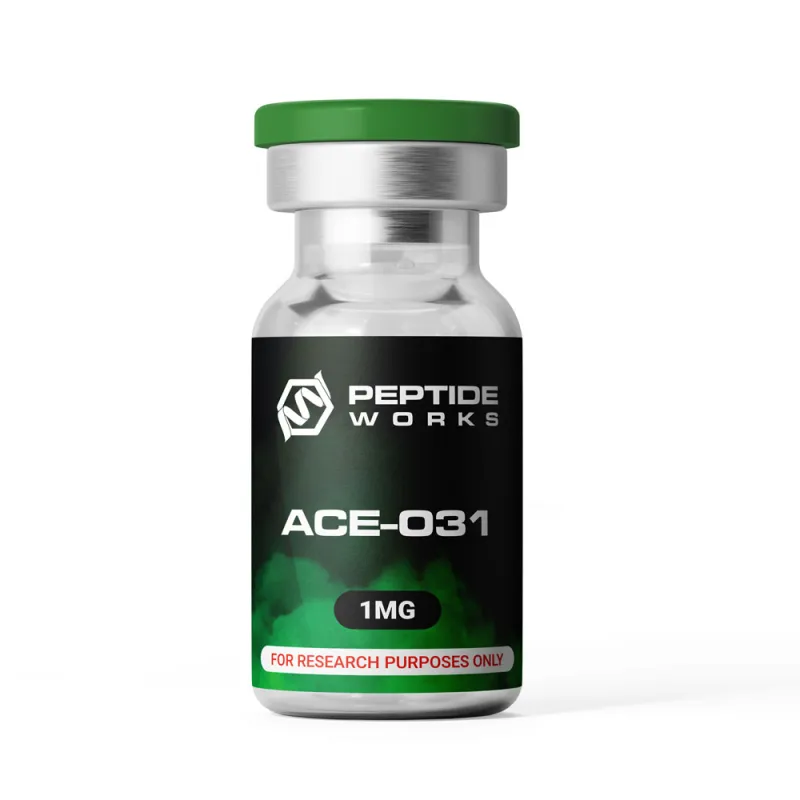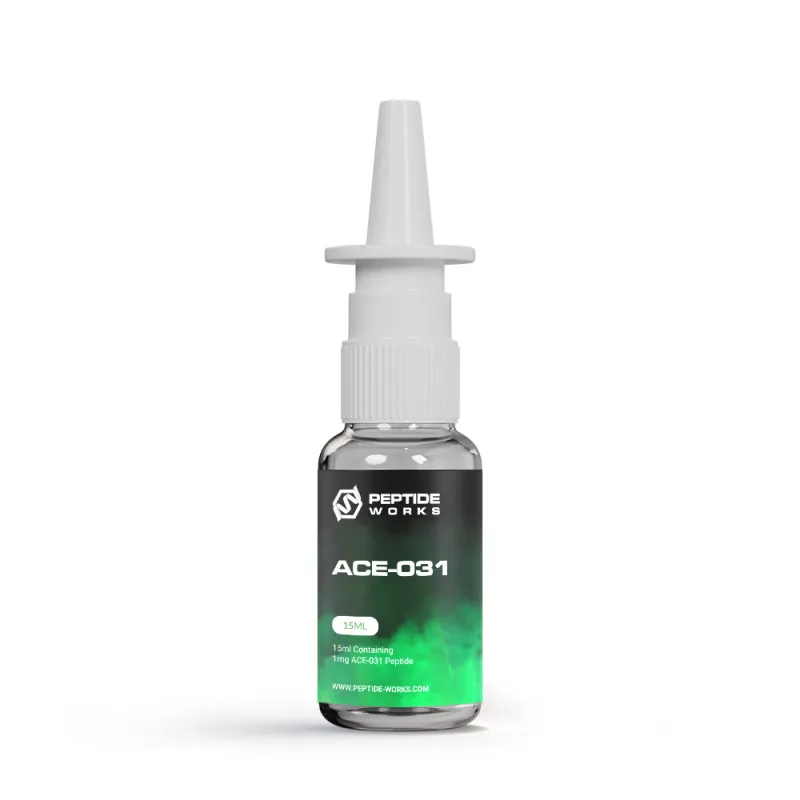
PROMO!
First order? Get 10% OFF with this code: 1storder

Recent lab studies show that peptide ACE-031 has real promise for fat reduction research. This synthetic research compound works by blocking myostatin – basically a protein that puts the brakes on muscle growth and affects body composition.
When myostatin gets blocked, studies suggest your body builds more lean muscle mass while reducing adipose tissue stores. Medical research found that participants had better fat metabolism biomarkers and lipid oxidation markers after treatment.
The research peptide also boosted lean body mass by 3.3% in just 29 days. However, ACE-031 is strictly for research use only and isn’t approved for human consumption.
Peptide Works supplies this research compound exclusively to researchers studying its effects on body composition and metabolic pathways.
Explore ACE-031 from Peptide Works, a research compound that traps myostatin to support enhanced muscle mass, strength, and skeletal muscle hypertrophy.

Think of myostatin as your body’s built-in brake system for muscle and fat balance regulation. When myostatin levels are high, it basically tells your muscles to stop growing and signals adipose tissue to store more energy as fat deposits.
Scientists have found that myostatin deficient mice had significantly less fat accumulation and improved body composition compared to normal mice, even as they aged.
The protein affects fat storage mechanisms through two main ways: it reduces fat burning capacity and decreases brown adipose tissue formation.
Lab experiments show that when myostatin gets blocked, test subjects show improved fat metabolism, enhanced lipolysis, and reduced fat mass. This happens because muscle tissue becomes more metabolically active at burning calories for energy expenditure.
Discover AOD-9604 from Peptide Works, a modified peptide fragment studied for its potential to reduce body fat and support metabolic function in lab research.
Myostatin influences several metabolic pathways involved in fat burning and energy metabolism. Reserachers have found that blocking myostatin can enhance the body’s natural fat burning processes and substrate utilization. These metabolic processes involve multiple enzyme systems that work together to break down stored adipose tissue.
Studies suggest that myostatin inhibition affects lipase activity and fatty acid oxidation, which helps break down fat molecules.
The protein also influences fat oxidation pathways and mitochondrial function in cells. Plus, myostatin appears to control enzymes involved in cellular energy production and metabolic flexibility.
Lab research shows improved metabolic enzyme function and enhanced substrate switching when myostatin gets blocked. Interestingly, other experimental peptides like AOD-9604 target different metabolic pathways through growth hormone mechanisms for comparison studies.

Fat oxidation happens inside cellular powerhouses called mitochondria through beta-oxidation pathways. Once lipase enzymes break down fat molecules, they enter a process called beta-oxidation and fatty acid metabolism. This metabolic pathway strips electrons from fat molecules to create ATP energy.
Researchers have found that peptide ace-031 enhances oxygen consumption during fat oxidation and improves respiratory exchange ratios.
Researchers discovered improved fat oxidation rates and substrate utilization in test subjects compared to control groups. The process requires oxygen to burn fat completely into carbon dioxide and water through oxidative metabolism.
Researchers measure fat oxidation using various metabolic markers and indirect calorimetry. When peptide ace-031 blocks myostatin, cells show enhanced fat burning, improved energy metabolism, and better metabolic flexibility. This metabolic improvement helps explain why the peptide reduces fat storage in lab studies.
Metabolic markers and biomarkers help researchers measure how well the body burns fat for energy and substrate utilization. Researchers use various fat metabolism biomarkers to determine if cells are effectively using fat as fuel and improving metabolic efficiency. These measurements provide valuable data about oxidative metabolism and energy expenditure.
Medical research shows peptide ace-031 improves several fat metabolism biomarkers and lipid oxidation markers in research subjects. This metabolic testing and biomarker analysis proves the peptide enhances the body’s ability to use fat for energy production and ATP synthesis.
Normal metabolic function involves switching between different fuel sources and substrate switching. Scientific validation through biomarker measurements and metabolic testing confirms that ace-031 improves metabolic flexibility and fat utilization rates in lab studies.

Metabolic flexibility and substrate switching mean your body can easily switch between burning fat and sugar for energy metabolism. Poor metabolic flexibility and substrate utilization keep you stuck burning sugar, which blocks effective fat loss and lipolysis.
Researchers have found that peptide ace-031 improves metabolic adaptation and fuel flexibility by enhancing the body’s fuel switching ability. Researchers discovered test subjects could transition from sugar burning to fat burning more efficiently after treatment. This metabolic flexibility and substrate switching is crucial because it allows continuous fat oxidation even when eating.
Enhanced metabolic responsiveness and improved substrate utilization also help maintain steady energy levels. When your body switches fuel sources efficiently, it maintains stable energy while burning stored fat and improving body composition. This metabolic improvement explains why ace-031 research subjects maintain fat loss over longer periods.
Peptide ace-031 helps maintain steady energy levels and metabolic stability during fat burning phases. When your body switches from sugar to fat for energy metabolism, proper metabolic function prevents energy fluctuations and metabolic slowdown. Researchers have found that peptide ace-031 improves overall metabolic stability and energy homeostasis in test subjects.
This research peptide also supports balanced hormone levels and endocrine function that affect energy regulation. Researchers discovered improved metabolic markers and better substrate utilization in subjects using ace-031 compared to control groups. This metabolic balance prevents the tired feeling that comes with traditional fat loss methods.
Additionally, peptide ace-031 supports muscle tissue preservation and lean mass maintenance while promoting fat burning and lipolysis. This tissue preservation effect helps maintain sustained energy levels throughout the day without the usual metabolic slowdown.
Scientists are developing next-generation peptides and research compounds that could revolutionize fat loss research and metabolic studies.
While peptide ace-031 shows promise through myostatin blocking and muscle growth enhancement, emerging research explores combination therapies using multiple research compounds. Early studies suggest combining different experimental peptides may create enhanced effects for fat metabolism and body composition.
Future medical trials and clinical research will focus on peptide innovation and therapeutic potential for metabolic disorders.
Researchers are investigating modified peptide structures with improved stability, bioavailability, and safety profiles. These emerging peptide therapies could offer more targeted fat reduction mechanisms and metabolic enhancement.
Peptide Works continues supplying research compounds and experimental peptides to laboratories and researchers worldwide.
However, all peptides remain strictly for research purposes only, not human consumption, as scientists work toward understanding their full potential.
[1] Attie KM, Borgstein NG, Yang Y, Condon CH, et al. A single ascending-dose study of muscle regulator ACE-031 in healthy volunteers. Muscle Nerve. 2013 Mar;47(3):416-23.
[2] Zhang C, McFarlane C, Lokireddy S, Masuda S, et al. Inhibition of myostatin protects against diet-induced obesity by enhancing fatty acid oxidation and promoting a brown adipose phenotype in mice. Diabetologia. 2012 Jan;55(1):183-93. doi: 10.1007/s00125-011-2304-4. Epub 2011 Sep 17. Erratum in: Diabetologia. 2015 Mar;58(3):643.
[3] Pan S, Zhang L, Liu Z, Xing H. Myostatin suppresses adipogenic differentiation and lipid accumulation by activating crosstalk between ERK1/2 and PKA signaling pathways in porcine subcutaneous preadipocytes. J Anim Sci. 2021 Dec 1;99(12):skab287.
[4] Puolakkainen T, Ma H, Kainulainen H, Pasternack A, Rantalainen T, Ritvos O, Heikinheimo K, Hulmi JJ, Kiviranta R. Treatment with soluble activin type IIB-receptor improves bone mass and strength in a mouse model of Duchenne muscular dystrophy. BMC Musculoskelet Disord. 2017 Jan 19;18(1):20.
[5] Attie KM, Borgstein NG, Yang Y, Condon CH, Wilson DM, Pearsall AE, Kumar R, Willins DA, Seehra JS, Sherman ML. A single ascending-dose study of muscle regulator ACE-031 in healthy volunteers. Muscle Nerve. 2013 Mar;47(3):416-23.
[6] Heffernan M, Summers RJ, Thorburn A, Ogru E, et al. The effects of human GH and its lipolytic fragment (AOD9604) on lipid metabolism following chronic treatment in obese mice and beta(3)-AR knock-out mice. Endocrinology. 2001 Dec;142(12):5182-9.
ALL CONTENT AND PRODUCT INFORMATION AVAILABLE ON THIS WEBSITE IS FOR EDUCATIONAL PURPOSES ONLY.
DISCLAIMER: These products are intended solely as a research chemical only. This classification allows for their use only for research development and laboratory studies. The information available on our Peptide Works website: https://peptide-works.com/ is provided for educational purposes only. These products are not for human or animal use or consumption in any manner. Handling of these products should be limited to suitably qualified professionals. They are not to be classified as a drug, food, cosmetic, or medicinal product and must not be mislabelled or used as such.
Peptide Works
Related Articles

Could Orexin A peptide Treat Daytime Fatigue?
Waking up tired frustrates many people. Dragging through a full day with heavy eyes and slow focus makes work and

How can the Adamax Peptide help Chronic Inflammation?
Chronic inflammation acts like a fire that never stops burning. It slows recovery, drains energy, and blocks proper tissue repair.

Can Vitamin B12 Immune System Support Enhance the Effects of Thymosin Alpha-1?
The Vitamin B12 immune system link is important because this vitamin plays a crucial role in DNA synthesis, methylation, energy